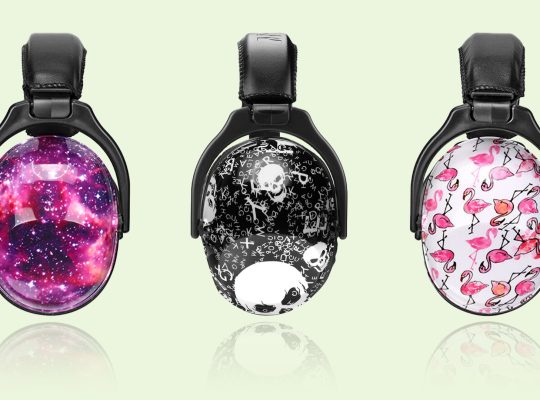Hearing protection is essential to protect your ears from harmful sounds without completely cutting yourself off from the environment. Filters play a crucial role in this. They regulate how sounds are attenuated and adjusted depending on the situation and needs of the user. In this comprehensive blog, we cover different types of filters, the meaning of colors, and important concepts such as SNR and NRR. We also explain how hearing protection filters work in specific scenarios such as flying, music listening, and industrial environments.
Why Are Filters Important?
Filters in hearing protection ensure that sound is attenuated in a controlled manner. This is especially important in situations where hearing protection is needed, but where you don’t want to be completely cut off from your surroundings. Think of concerts, for example, where you want to enjoy the music without suffering hearing damage, or in industrial environments where communication remains crucial.
Without filters, ear plugs or earmuffs would attenuate all sounds equally, which can be uncomfortable and even dangerous. Filters allow certain frequencies to be emphasized or reduced, depending on the application.
Different Types of Filters
High Tone Filters
High-tone filters are designed to attenuate primarily high frequencies. This type of filter is often used in situations with loud, shrill sounds, such as factory environments or when using power tools. By reducing only high-pitched sounds, lower frequencies remain audible, which can be useful for understanding speech, for example.
Flat filters
Flat filters are ideal for musicians and music lovers because they offer even attenuation across all frequencies. This means that sounds are not distorted, but simply sound softer. As a result, music maintains its natural balance, which is important for performing artists and listeners alike.
Impact filters
Impact filters are designed to protect against sudden, loud noises, such as gunshots or explosions. They are often used in shooting sports, military use, or other situations where impulse noise is common. These filters allow normal sounds to pass through, so you can still communicate or listen to your surroundings.
Pressure Regulating Filters
Pressure-regulating filters are often used in flying and mountain climbing, where changes in air pressure can cause discomfort in the ears. These filters help reduce pressure differences in the ears, making for a more comfortable experience. They are also suitable for people who suffer from sensitive ears during high-altitude travel.
The Meaning of Filter Colors
Many hearing protection products use color coding to distinguish different filters. These colors help users quickly identify which filter is appropriate for which application:
- Red: High-tone attenuation or maximum protection.
- Blue: Even attenuation for a natural listening experience.
- Yellow: Pressure regulation, suitable for flying or high altitude activities.
- Green: Comfortable general hearing protection.
- Orange: Suitable for impulse noise like impact filters.
Color coding makes it easy to choose the right type of hearing protection for your specific situation.
What Are SNR and NRR?
SNR (Single Number Rating).
SNR stands for Single Number Rating and indicates how much noise the hearing protection attenuates, expressed in decibels (dB). A higher SNR value means a higher degree of attenuation. SNR values are determined based on testing in controlled laboratories and provide a reliable indication of average protection.
As an example, an SNR of 30 dB means that the hearing protection reduces an average noise level by 30 dB. For example, if you are in an environment with a noise level of 100 dB, it will be reduced to 70 dB.
NRR (Noise Reduction Rating).
NRR stands for Noise Reduction Rating and is primarily used in the United States. The concept is similar to SNR, but the testing methods differ. NRR values are often lower because they are more conservative in estimating actual attenuation in real-world situations.
Difference between SNR and NRR
SNR and NRR are similar concepts, but they are not directly interchangeable because of the different testing methodologies. In Europe, SNR is more commonly used, while NRR is more common in the US. Both are valuable tools for choosing the right hearing protection.
Application of Filters in Different Situations
Music and Concerts
Filters with flat attenuation are ideal for music lovers and concertgoers. They protect your hearing without compromising the quality of the music. This also makes them popular with musicians who want to protect their hearing during rehearsals or performances.
Flying and Traveling
Pressure-regulating filters provide comfort during air travel or activities at high altitudes. They minimize pressure differences and reduce discomfort in the ears, which is especially useful for people sensitive to air pressure changes.
Industrial Use
In industrial environments where loud and constant noises are present, such as in factories, high-tone filters offer protection while still allowing you to communicate with colleagues.
Shooting Sports and Safety
Impact filters are specially designed to protect against sudden, loud noises. They are widely used in shooting sports, fireworks, military use, and other environments with explosive sounds.
Overview Table Filters for Hearing Protection
| Type of Filter | Features | Application | Color |
|---|---|---|---|
| High-pitched | Reduces high frequencies, retains low frequencies | Industry, power tools | Red |
| Flat filter | Even attenuation, preserves natural sound experience | Music, concerts, rehearsals | Blue |
| Impact filter | Protects against sudden loud noises, such as gunshots and fireworks | Shooting sports, explosive environments, fireworks | Orange |
| Pressure regulating | Minimizes pressure differences in the ears, prevents discomfort | Flying, mountain climbing | Yellow |
Conclusion
Hearing protection filters are a crucial part of effective hearing protection in a variety of situations. By choosing the right filters, you can protect your hearing without missing important sounds. Terms like SNR and NRR help you understand the degree of protection, while color-coding helps you quickly choose the right product. With the right hearing protection, you’ll enjoy comfort, safety, and a healthy listening experience.






